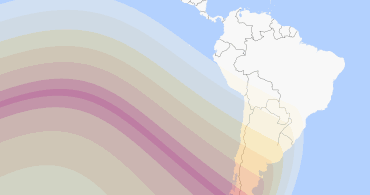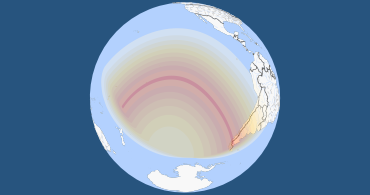A total solar eclipse occurs on July 11, 2010. Tourists and inhabitants on Easter Island (Rapa Nui or Isla de Pascua) and other small islands in the southern Pacific Ocean, as well as in southern Argentina and Chile in South America, can witness this eclipse.
This eclipse wasn't visible in Columbus - Which upcoming eclipses can be seen in your location?
Where the Eclipse Was Seen
Try our new interactive eclipse maps. Zoom in and search for accurate eclipse times and visualizations for any location.
Path of the Eclipse Shadow
Regions that saw, at least, a partial eclipse: South/West South America, Pacific.
The eclipse's path
The total solar eclipse on July 11, 2010 is visible in parts of South Amermica, but it does not touch the mainland until sunset. Therefore, those wishing to witness this eclipse on mainland southern Argentina and Chile see it during sunset.
The best place to watch the eclipse is Easter Island, but it is also visible in places such as Mangaia (Cook Islands) and Wellington Island, which is off the coast of Chile. The path of totality ends after reaching southern Chile and Argentina. The moon’s penumbral shadow produces a partial eclipse visible from a large region covering the South Pacific and southern South America.
This eclipse wasn't visible in Columbus - Which upcoming eclipses can be seen in your location?
Eclipse Shadow Path
0%
>0%
40%
90%
100%
The dark areas symbolize night and twilight.
When the Eclipse Happened Worldwide — Timeline
The eclipse started at one location and ended at another. The times below are actual times (in UTC) when the eclipse occurred. This calculation uses a Delta T value of 66.2 seconds.
| Eclipse Stages Worldwide | UTC Time | Local Time in Columbus* |
|---|---|---|
| First location to see the partial eclipse begin | Jul 11 at 17:09:37 | Jul 11 at 1:09:37 pm |
| First location to see the full eclipse begin | Jul 11 at 18:15:12 | Jul 11 at 2:15:12 pm |
| Maximum Eclipse | Jul 11 at 19:33:31 | Jul 11 at 3:33:31 pm |
| Last location to see the full eclipse end | Jul 11 at 20:51:40 | Jul 11 at 4:51:40 pm |
| Last location to see the partial eclipse end | Jul 11 at 21:57:15 | Jul 11 at 5:57:15 pm |
* These local times do not refer to a specific location but indicate the beginning, peak, and end of the eclipse on a global scale, each line referring to a different location. This eclipse isn't visible in Columbus.
Upcoming eclipses visible in Columbus
Next Total Solar Eclipse will be on Nov 13 – Nov 14, 2012
Eclipse calculations usually accurate to a few seconds
Countries Where the Eclipse Is Visible
| Country | Type | Start of Eclipse | End of Eclipse |
|---|---|---|---|
| Argentina | Total Solar Eclipse | 4:43 pm ART | 6:54 pm ART |
| Chile | Total Solar Eclipse | 12:40 pm EAST | 5:56 pm CLT |
| Cook Islands | Total Solar Eclipse | 7:09 am CKT | 9:36 am CKT |
| French Polynesia | Total Solar Eclipse | 7:12 am TAHT | 11:33 am GAMT |
| American Samoa | Partial Solar Eclipse | 6:38 am SST | 8:12 am SST |
| Bolivia | Partial Solar Eclipse | 4:20 pm BOT | 5:42 pm BOT |
| Brazil | Partial Solar Eclipse | 5:19 pm BRT | 5:24 pm AMT |
| Ecuador | Partial Solar Eclipse | 1:56 pm GALT | 2:47 pm GALT |
| Falkland Islands | Partial Solar Eclipse | 3:50 pm FKT | 4:14 pm FKT |
| Fiji | Partial Solar Eclipse | 6:25 am FJT | 7:08 am FJT |
| Kiribati | Partial Solar Eclipse | 7:11 am LINT | 9:38 am LINT |
| New Zealand | Partial Solar Eclipse | 6:46 am NZST | 8:23 am CHAST |
| Niue | Partial Solar Eclipse | 6:53 am NUT | 8:15 am NUT |
| Paraguay | Partial Solar Eclipse | 4:26 pm PYT | 5:37 pm PYT |
| Peru | Partial Solar Eclipse | 3:19 pm PET | 4:33 pm PET |
| Pitcairn Islands | Partial Solar Eclipse | 9:47 am PST | 1:01 pm PST |
| Samoa | Partial Solar Eclipse | 6:50 am WST | 8:07 am WST |
| Tokelau | Partial Solar Eclipse | 6:41 am TKT | 8:00 am TKT |
| Tonga | Partial Solar Eclipse | 7:08 am TOT | 8:13 am TOT |
| Tuvalu | Partial Solar Eclipse | 6:17 am TVT | 6:51 am TVT |
| US Minor Outlying Islands | Partial Solar Eclipse | 6:15 am | 8:03 am |
| Uruguay | Partial Solar Eclipse | 5:14 pm UYT | 6:06 pm UYT |
| Wallis and Futuna | Partial Solar Eclipse | 6:08 am WFT | 7:01 am WFT |
All times shown in this table are local time. (Note: more than one time zone is listed.)
How Many People Can See This Eclipse?
| Number of People Seeing... | Number of People* | Fraction of World Population |
|---|---|---|
| Any part of the eclipse | 108,000,000 | 1.55% |
| At least 10% partial | 58,200,000 | 0.83% |
| At least 20% partial | 50,200,000 | 0.72% |
| At least 30% partial | 42,300,000 | 0.61% |
| At least 40% partial | 20,300,000 | 0.29% |
| At least 50% partial | 9,740,000 | 0.14% |
| At least 60% partial | 6,260,000 | 0.09% |
| At least 70% partial | 2,840,000 | 0.04% |
| At least 80% partial | 1,200,000 | 0.02% |
| At least 90% partial | 624,000 | 0.008% |
| Totality or annularity | 95,900 | 0.001% |
* The number of people refers to the resident population (as a round number) in areas where the eclipse is visible. timeanddate has calculated these numbers using raw population data provided by the Center for International Earth Science Information Network (CIESIN) at Columbia University. The raw data is based on population estimates from the year 2000 to 2020.

An Eclipse Never Comes Alone!
A solar eclipse always occurs about two weeks before or after a lunar eclipse.
Usually, there are two eclipses in a row, but other times, there are three during the same eclipse season.
This is the second eclipse this season.
First eclipse this season: June 26, 2010 — Partial Lunar Eclipse
Eclipses in 2010
- An annular solar eclipse on January 15.
- A partial lunar eclipse on June 26.
- A total solar eclipse on July 11.
- A total lunar eclipse on December 21.

